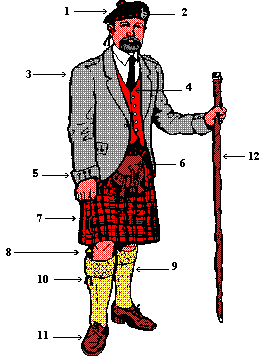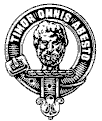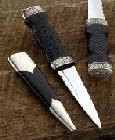If you've already worn the kilt, you're probably an old hand at it, and there's not much I can tell you about the "proper" way to wear it or it's accessories (we Scots get pretty set in our ways). But if you have never worn one, or are just curious about it, we'll see if we can give you a few pointers on this page.
Now, don't get the idea that I'm a "purist" and am going to tell you that this is the only way it can or should be worn - I'm probably more of a rebel when it comes to that than most. I don't believe the Scots of yesteryear kept a wardrobe full of accessories, this for day, that for evening, black leather for now, and only leather sporrans in the daytime etc... That's really stretching it. There are, however, a few things that I believe are not acceptable, and a real Scot would either laugh at you, or be so embarassed, that he wouldn't want to be around you.
 The
figure you see at left represents what a Scot would wear for activities
calling for a jacket such as hillwalking (thus the walking stick) or regular
day-to-day wear when you didn't want to be in your shirt-sleeves. This
would also be good for informal evening wear for anywhere or any time you
would go out in a pair of slacks (jeans?) and maybe a sport jacket with
tie. We'll name the items by the number, and give a brief explanation:
The
figure you see at left represents what a Scot would wear for activities
calling for a jacket such as hillwalking (thus the walking stick) or regular
day-to-day wear when you didn't want to be in your shirt-sleeves. This
would also be good for informal evening wear for anywhere or any time you
would go out in a pair of slacks (jeans?) and maybe a sport jacket with
tie. We'll name the items by the number, and give a brief explanation:
1. The Balmoral bonnet is the modern version
of the old Scottish flat cap and is worn much the same as a beret, tilted
slightly forward with the top pulled over the right ear so the cockade
(the patch of ribbon sewn onto the left side) stands up. Balmorals come
in many different colors, and you should choose one to more-or-less match
the remainder of your clothing. You cannot go wrong with a dark blue. The
wee pom-pom on top is called a toorie. All Balmorals will have the ribbons
at the back (originally designed for adjusting the fit). These ribbons should be tied into a neat bow, not worn untied and hanging
down the back. You can buy your bonnet with colored dicing around the band.
This dicing smacks a bit much of the military and I personally prefer my
bonnet without. My first action upon buying a new bonnet has always been
to wet it down good, put it on my head, and shape it the way I want it.
I heard someone say that a balmoral is not ready for wear until it's been
dunked in a puddle or two, and kicked a quarter of a mile down the road.
These ribbons should be tied into a neat bow, not worn untied and hanging
down the back. You can buy your bonnet with colored dicing around the band.
This dicing smacks a bit much of the military and I personally prefer my
bonnet without. My first action upon buying a new bonnet has always been
to wet it down good, put it on my head, and shape it the way I want it.
I heard someone say that a balmoral is not ready for wear until it's been
dunked in a puddle or two, and kicked a quarter of a mile down the road.
 2.
The clan badge is the clan chief's crest, surrounded by his motto on a
buckled strap. You do not wear a feather or feathers behind this
badge unless you are a clan chief, chieftain, or bear your own arms as
approved by the Lord Lyon of Scotland! Being Chief or Chieftain of an American
Clan Society does not fulfill this requirement.. If you wish, you can wear
the "plant badge" associated with your clan. In fact, I think it would
be good if more American Scots did so.
2.
The clan badge is the clan chief's crest, surrounded by his motto on a
buckled strap. You do not wear a feather or feathers behind this
badge unless you are a clan chief, chieftain, or bear your own arms as
approved by the Lord Lyon of Scotland! Being Chief or Chieftain of an American
Clan Society does not fulfill this requirement.. If you wish, you can wear
the "plant badge" associated with your clan. In fact, I think it would
be good if more American Scots did so.
3. The jacket shown is a Harris tweed with epaulets at the shoulders and gauntlet type cuffs. Buttons are usually of bone (or plastic nowadays) for day wear. This jacket is cut shorter than a sassanach sport coat, and rounded at the front to accomodate the sporran. Don't get the idea that you must wear a jacket with the kilt - for normal wear on warm days, shirtsleeves or sweaters are perfectly fine - and when it's hot and you're exerting yourself - there's nothing wrong with stripping to your t-shirt.
4. The vest or waistcoat is an optional item which may or may not be worn, but looks pretty sharp for informal evenings out.
5. Gauntlet cuffs are one of the options usually offered on most kilt jackets. It's said that the gauntlet cuffs with the row of buttons were originally intended to keep the uniformed soldiers from wiping their noses on the cuff of their uniform jackets. Don't know if it worked or not.
6. A sporran is a real necessity with a kilt. No pockets! Day wear sporrans are usually of leather (either black or brown) and worn on a strap. Some wear the sporran on a chain, but I have found that the chain will eventually cause unwanted wear to the kilt itself, so I would suggest staying away from them except for formal or evening wear. One sporran which will serve for all occasions is a fur sporran with the animal's head made into the flap that closes it. Woodchuck, badger, and even skunk, make a good sporran for all-around wear. For formal and evening wear, a fur sporran is a must.
7. Ah yes, the kilt - that's what this was all about.. Your kilt is made-to-measure from the tartan of your choice. If you do not have a clan tartan, there are several other choices that are competely acceptable, including a solid color. You have a wide assortment of district - and even State - tartans to chose from. Talk to your dealer about the finer points of having a kilt made. One thing - do not have your kilt made too long! Middle of the knee, or even a bit above, is the route to go. If it comes below that, it not only looks hokey, but that worsted wool will cut into the soft skin at the back of your knees in short order! The kilt shown is the feilebeg or small kilt - hate to tell you this - but it's said to be the invention of an Englishman! Well sometimes they do something right. It was invented for Scotsmen!
8. The sgian dubh or "black knife" was said
to be the last defense of the Highlander. It  was
normally carried as a hide-out weapon, supposedly under the armpit or some
other hidden location. When entering another's home (castle) the knife
was taken out and placed in the top of the stocking to show that no harm
was intended and no hidden weapons were carried. You'll see most carried
in the outside top of the right stocking, but either side is fine. If you're
a lefty, it's much handier on that side. (They're good for cutting up your
whisky steaks!)
was
normally carried as a hide-out weapon, supposedly under the armpit or some
other hidden location. When entering another's home (castle) the knife
was taken out and placed in the top of the stocking to show that no harm
was intended and no hidden weapons were carried. You'll see most carried
in the outside top of the right stocking, but either side is fine. If you're
a lefty, it's much handier on that side. (They're good for cutting up your
whisky steaks!)
9. Your kilt hose should be of a color which compliments your tartan, and is worn just below the knee, turned down at the top, over the flashes. Many colors are available for day wear and, although the "purists" will say white or a matching argyle is a must for evening wear, I have been known to wear a dark green, which goes well with my MacNab tartan. To each his own.
10. Hose flashes as worn today are representative of the tied garters of olden days, and come in several colors also.
11. Day wear shoes can be of either black or brown (match your sporran) and are usually a good, heavy leather. A good wing-tip shoe is fine, or you can go the route of buying a pair of "gillies" with the long strings which tie up around the leg and have no tongue. Again, to each his own. Please - don't wear tenny-runners!
12. Ah yes, the gentleman has a walking stick - handy for us older fellas, and makes a good weapon for beating off all the lassies who will be following you around, once you don the kilt! Or you can get a regular cromach, the crook-handled walking stick, and pull them in!
P.S. If you're going to wear a kilt pin - don't
pin it through both thicknesses of your kilt. That's a good way to cause
an irrepairable rip, if you should happen to catch the kilt apron on anything.
That pretty much takes care of regular, every-day wear of the kilt and some of the possible accessories. One thing which I would like to leave you with - leave the plaids alone - the shoulder plaid, when used for daytime, is folded lengthwise and carried over the shoulder much as a blanket you'd take to the ballgame. The ONLY time a plaid should be worn pinned and hanging is if you are a band member and it's part of your uniform, or if you are in FULL dress formal wear, which is something that most of us will never see in our lifetime. Remember, the kilt and it's associated accessories are not a costume, and should be worn with pride, and worn right. As a representative of a proud people, past and present, you owe that much to the heritage.
Want to go full dress? check out the drawing at right. This gentleman is wearing the breacan feile (great kilt), Sheriffmuir doublet, badger sporran, castellated argyle hose and silver buckled shoes. The fullest of full dress. Boy, if I only could afford that! Now, just where would I wear it?
![]()
